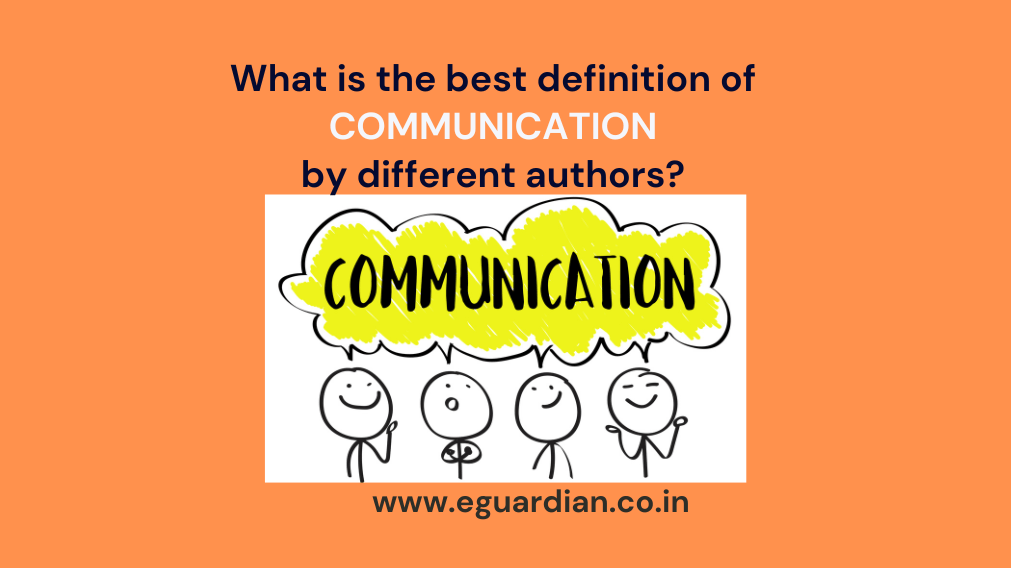Communication is an intricate web that connects the world. From ancient philosophers to modern scholars, countless thinkers have attempted to unravel the true essence of communication. But with so many perspectives and interpretations, the question remains: what is the best definition of communication?
In this article, we will delve into the thoughts and theories of different authors throughout history to find clarity amidst a sea of ideas. Whether you are a curious student or simply seeking a deeper understanding of human connection, you have arrived at the right destination to explore the multifaceted nature of communication and discover what truly lies at its core.

Introduction
Communication is integral to human interaction and crucial in conveying ideas, thoughts, and information. Over the years, different authors and scholars have proposed various definitions of communication.
Communication is sharing information, ideas, and emotions between people or groups. It involves a sender, a message, a medium, and a receiver. Effective communication requires transmitting a message clearly and understandably.
Communication is a complex process involving sharing information, ideas, and emotions between two or more people. It is essential for our personal and professional lives and plays a vital role in society as a whole.
What is the best definition of communication by different authors?
Lets discuss the answers for above question. Communication has many different definitions, but they all share some common elements. Communication involves a sender, a message, a receiver, and a shared meaning.
The sender encodes the message, which is then decoded by the receiver. The message is successful if the receiver understands the meaning that the sender intended to convey.
Different authors have proposed different definitions of communication. Here are a few examples:
- The American Psychological Association (APA) defines communication as “The exchange of information between individuals using symbols, signs or behaviors.”
- The International Communication Association (ICA) defines communication as “the process by which individuals create and share information to achieve common goals.”
- The National Communication Association (NCA) defines communication as “the process of creating and sharing meaning through symbols.”
These definitions all emphasize the importance of shared meaning in communication. For communication to be successful, the sender and receiver must have a shared understanding of the symbols being used.
Shannon-Weaver Model of Communication
The Shannon-Weaver communication model, proposed by Claude Shannon and Warren Weaver, provides a mathematical communication theory. It is one of the most influential models in communication studies.
Claude Shannon
Claude Shannon, an American mathematician and electrical engineer, introduced the concept of information theory. He defined communication as transmitting information from a sender to a receiver over a noisy channel.
Warren Weaver
Warren Weaver, an American scientist and mathematician, collaborated with Claude Shannon to develop the Shannon-Weaver model. He emphasized the importance of understanding the psychological and social aspects of communication.
Key Concepts: The Shannon-Weaver model emphasizes the following key concepts:
a. Sender: The person or entity initiates the communication by encoding a message.
b. Message: The information, ideas, or thoughts being conveyed.
c. Channel: How information is conveyed, such as speaking, writing, or electronic communication.
d. Receiver: The person or entity who receives and decodes the message.
5. Noise: Any interference or distortion that affects the clarity of the message during transmission.
Harold D. Lasswell’s Definition
Harold D. Lasswell, an American political scientist, focused on the content and impact of communication. He defined communication as “who says what, through which channel, to whom, with what effect.”
Lasswell’s definition highlights the importance of understanding the sender’s intentions, the message’s content, the chosen medium, the intended audience, and the resulting impact on the receiver.
Wilbur Schramm’s Definition
Wilbur Schramm, an American communication theorist, contributed significantly to mass communication. He defined communication as “the process by which one mind affects another.”
Schramm emphasized the interactive nature of communication and its influence on shaping individuals’ thoughts and perceptions.
David Berlo’s SMCR Model
David Berlo, an American communication theorist, proposed the SMCR communication model. According to Berlo, communication involves four elements: source, message, channel, and receiver.
Berlo’s model emphasizes the importance of effective encoding and decoding of the message, as well as the role of feedback in ensuring successful communication.
Michael Argyle’s Communication Cycle
Michael Argyle, a British social psychologist, developed the communication cycle model. According to Argyle, communication is a cyclical process that involves several stages, including encoding, transmission, decoding, and feedback.
Argyle’s model emphasizes the dynamic nature of communication and the importance of feedback in ensuring effective understanding and interaction.
⇒ Robert Anderson:
“Communication is the interchange of thoughts, opinions, or information by speech, writing, or signs.”
⇒ E. Griffins:
“Communication is the relational process of creating and interpreting messages that elicit a response.”
⇒ D.E. McFarland:
“Communication may be broadly defined as the process of meaningful interaction among human beings.”
⇒ Louis Allen:
“Communication is the sum of all the things one person does when he wants to create understanding in the mind of another. It is a bridge of meaning. It involves a systematic and continuous process of telling, listening, and understanding.”
⇒ William Newman and Charles Summer:
“Communication is an exchange of ideas, facts, opinions, or emotions by two or more persons.”
⇒ Keith Davis:
“Communication is the process of passing information and understanding from one person to another. It is essentially a bridge of meaning between people.”
⇒ Theo Haiman:
“Communication means the process of passing information and understanding from one person to another.”
⇒ Peter Little:
“Communication is the process by which information is transmitted between individuals and/or organizations so that an understanding response results.”
⇒ C.G. Brown:
“Communication is the transfer of information and understanding from one person to another, which results in a common understanding between the sender and the receiver.”
FAQs related to communication
Ques 1. What is the Shannon-Weaver model of communication?
Ans: The Shannon-Weaver model is a mathematical theory of communication that defines communication as transmitting information from a sender to a receiver over a noisy channel.
Ques 2. What is the importance of feedback in communication?
Ans: Feedback plays a crucial role in communication as it allows the sender and receiver to assess the effectiveness of the message and ensure mutual understanding.
Ques 3. How does communication affect relationships?
Ans: Having effective communication skills is crucial for establishing and sustaining relationships. It helps express emotions, resolve conflicts, and foster understanding and trust among individuals.
Ques 4. Why is communication important in the workplace?
Ans: Communication is essential for effective collaboration, sharing information, conveying expectations, and facilitating teamwork and productivity in the workplace.
Ques 5. What are the key elements of the communication process?
Ans: The communication process includes five key elements: sender, message, channel, receiver, and feedback. These elements work together to facilitate the exchange of information and ideas.
Conclusion
Communication is a complex and multifaceted process studied and defined by various authors and scholars. From the mathematical perspective of Shannon and Weaver to the interactive models of Schramm, Berlo, and Argyle, each definition brings a unique perspective to understanding the intricacies of communication.
Regardless of the definition, it is clear that effective communication is essential for fostering understanding, building relationships, and achieving successful outcomes in various personal, professional, and social contexts.



